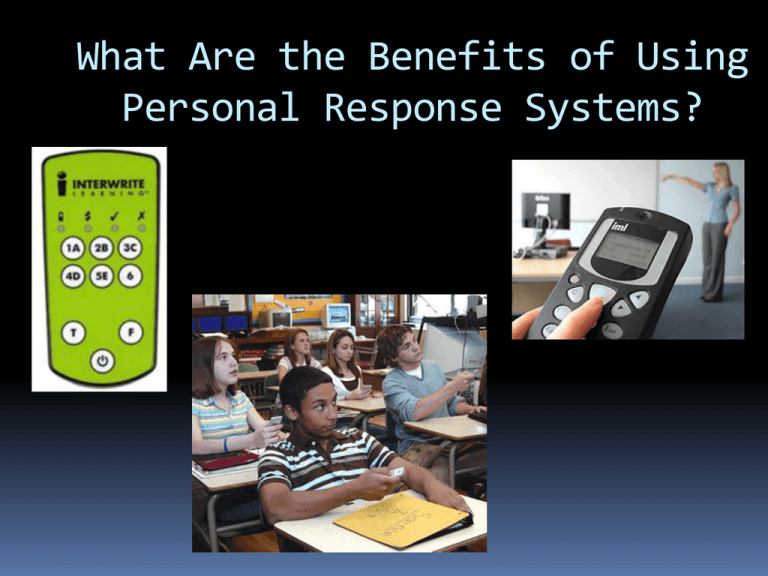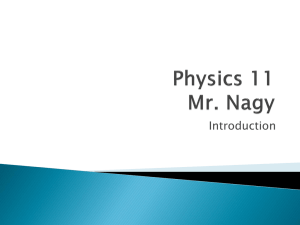What Are the Benefits of Using Personal Response Systems
advertisement

What Are the Benefits of Using Personal Response Systems? Uses of Personal Response Systems •Stimulate Classroom Discussion •After initial answer, pair students or have class discussion about the polling results which in turn fosters critical thinking skills •Re-poll after discussion to see how knowledge, attitudes or opinions have changed •Assess Students’ Comprehension of course Material through low-stakes testing •Allows students to gauge their own mastery of concepts •Provides Immediate Feedback to Faculty on students’ understanding •“just in time” teaching •2-4 questions per 50 minute period •This allows time for peer teaching and group discussion • Questions should have a clearly defined pedagogical goal such as: • Drawing out background knowledge • Discovering points of confusion or misconception • Distinguishing two related concepts • Question Wrap-up is an important part of the process • Summarization firms student understanding before moving on to next topic •Difference between what students are exposed to and what they learn – Measure what students know before you start to teach them –Measure student attitudes –Find out if they’ve done the reading –Get students to confront common misconceptions –Test student understanding –Increase student’s retention of what you teach • Active participation = longer retention –Facilitate discussion and peer teaching –Increase class attendance –Improve student attitudes –Easy and effective way to increase student participation • fun, anonymous and unthreatening manner 94% 1. Clickers increased student engagement in the classroom 6% 0% 87% 2. Clickers increased student participation in the course 13% 0% Agree or Strongly agree Neutral Disagree or Strongly Disagree 68% 3. Clickers facilitatied good interactions betweens students in the course 23% 10% 82% 4. Clickers allowed me to stimulate class discussion based on data received 10% 8% (Kaleta,, & Joosten, 2007) 0 10 20 30 40 50 60 70 80 90 100 69% 1. Clickers led me to become engaged in the class 18% 13% 70% 2. Clickers increased the frequency of my participation in the course. Agree or Strongly Agree 17% Neutral Disagree or Strongly Disagree 13% 67% 3. Using clickers helped me to pay attention in class. 17% 16% (Kaleta,, & Joosten, 2007) 0 10 20 30 40 50 60 70 80 Clickers allowed me to assess student knowledge on a particular concept 100% 0% 0% 74% Agree or Strongly Agree Clickers have been beneficial to my students' learning 26% Neutral Disagree or Strongly Disagree 0% Clickers have increased my students' overall performance in the class 58% 35% 6% (Kaleta,, & Joosten, 2007) 0% 10% 20% 30% 40% 50% 60% 70% 80% 90% 100% •Instructors must learn new skills and roles •Instructors must become comfortable with the new technology and be able to troubleshoot any technical glitches during class •Requires a new way of designing instruction •Must view themselves as engineers of learning experiences rather than a dispenser of knowledge (Beatty, I, 2004) •Classroom management and Quick Thinking •Become a learning coach instead of •Giving up control •PRS turns control over to the students while they debate and defend their position after viewing other’s response Beatty, I, Initials. (2004). Transforming studetn learning with classroom communication systems. Educase Applied Research Center, 2004(3), Retrieved from D'Arcy,C., Initials, Eastburn, D., Initials, & Mullally, K., Initials. (2007). Effective use of a personal response system in a general education palnt pathology class. APS net, The Plant Health Instructor, Retrieved from http://apsnet.org/Education/InstructorCommunication/TeachingArticle s/PRSPathology/default.htm doi: 10.1094 Kaleta,, R., & Joosten, T. (2007). Student response systems: a univesity of wisconsin system study of clickers. Educase Center for Applied REsearch, 2007(10), Retrieved from http://ctl.stanford.edu/PRS/Kaleta_Joosten_PRS_Wisconsin.pd







